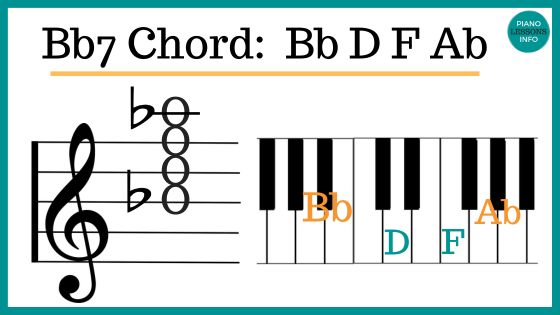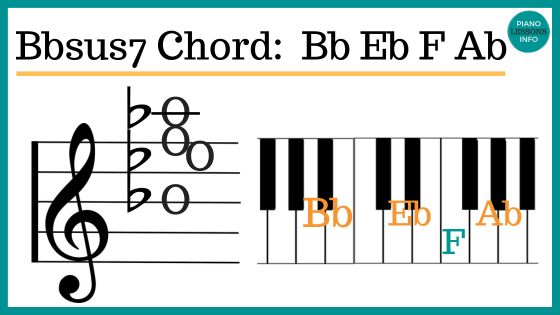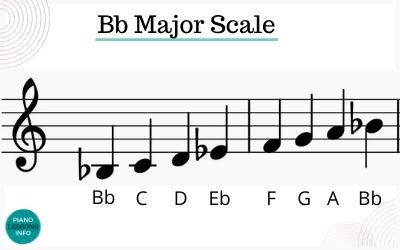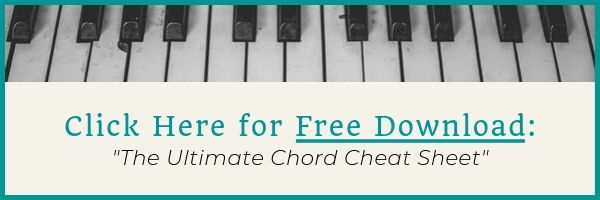How to Play Bb7 Piano Chord
The Bb7 piano chord isn't one of the first 7th chords you learn but it is one of the more commonly played 7th chords. Especially in key signatures with flats. So this is a great one to learn and have under your belt.
We'll go over:
- Bb7 chord notes
- what Bb7 should sound like (there's a video)
- chord variations including Bb7sus4, Bb7#5 and Bb7b9
- and chord theory of the formula involved in creating this chord
Bb7 Piano Chord Notes
The Bb7 chord is made up of the notes Bb, D, F and Ab.
Let's break this chord down a bit.
The Bb in this chord is the root note and the small "b" refers to a flat. So this is a B flat seventh chord.
The 7 is the type of chord it is. In this case, it's a 7th chord. Technically, this is also called a dominant seventh chord.
A dominant seventh chord has no m - large or small - in the chord title. If you see m7 that is a minor seventh chord. If you see M7 that's a major seventh chord. Both different than just the 7 used in the chord title for 7th chords.
 Bb7 Piano Chord Chart
Bb7 Piano Chord ChartBb = root note, B flat
7 = seventh chord
How to Play Bb7 Chord
You'll see in the video below that Bb7 needs to be played pretty high up in the keys to comfortably play this chord. Sometimes when I'm teaching people, they wonder if that is okay and it is. It's fine and more comfortable to play like that, at least for me.
You'll learn how to play this chord plus hear what it sounds like in the video below.
Bb7 Piano Chord Variations
There are multiple ways you can alter or add to the Bb7 chord, especially while playing jazz. Here the some of the most common chord variations using Bb7 as it's foundation.
Bb7sus4 Piano Chord
The Bb7sus, Bb7sus4, or Bbsus7 are all the same thing - a B flat seventh suspended chord.
This is how we break this chord down.
Root note: Bb
Sus or Sus 4: refers to the Bb suspended chord, we are playing Eb instead of instead of D. This is what makes it sound suspended.
7: we add the Ab which is the 7th note.
The notes of the Bb7sus4 chord are Bb, Eb, F, Ab.

If you're not sure of chord formulas, we will be using that to explain the following chords. You could pop down to the chord theory section and then back here again to understand these specific chords.
Bb7#5 Chord
With the Bb7#5 chord, you play the Bb7 chord but need to alter the 5th note in this chord. In this case we need to make it sharp or raise it one semitone.
The notes of the Bb7#5 chord are: Bb D F# Ab.
Notice that the F gets raised to F# and that is why you have it written as #5.
Bb7#9
With the Bb7#9 chord, there are a few things we need to understand in order to work out the notes of this chord. First, you play the Bb7 chord as is - Bb, D, F, Ab.
Next, we need to work out #9. To do this, you need to count up the major scale until you hit note 9 - in this case it is C.
So 9 = C.
Now you need to make that sharp or raise it one semitone. C becomes C#.
The notes of Bb7#9 are: Bb D F Ab C#.
Sometimes the 5th - in this case F - is left out of these chords when played as you only have so many fingers.
Bb7b9
Bb7b9 is very similar to Bb7#9 only instead of making the 9th note of the scale sharp, we need to make it flat.
So we use all the notes of the Bb7 chord - Bb D F Ab.
Then we need to find the 9th note by counting up from Bb until we hit the 9th note - C.
Now we make that flat. C becomes Cb. Remember that Cb is also the same note as B so this chord has a minor second in it that may sound like it is really clashing.
The Bb7b9 notes are: Bb D F Ab Cb (B).
Bb7 Chord Formula & How to Remember This Chords
All 7th chords use a specific formula combined with the key signature that tell you what the notes of a chord are.
All 7th chords are built on the 1st, 3rd, 5th and lowered 7th notes of the major scale. Lowered means it goes down one semitone.
Seventh chord formula: 1, 3, 5, b7
So what we need next is the major scale. In this case, it's the Bb major scale that we're working with.

Finding the 1st, 3rd, 5th and lowered 7th notes of the Bb major scale will give us the Bb7 chord.
1 = Bb
3 = D
5 = F
b7 = Ab (A gets lowered one semitone to Ab)
This is why it's really great to know your scales and your key signatures.
If you need more help understanding key signatures, visit the key signatures page.
If you need to look up more chords, visit the Piano Chord Charts page or download your own copy below.
Is Bb7 & A#7 the Same Thing
One great question that comes up with this chord is if it is the same as A#7. In short, the answer is yes. However, generally Bb7 should be used instead of A#7.
Sometimes people think sharps and flats can be used interchangeably and when they write music, they might use an A# instead of a Bb.
If you are writing music, I would say to use Bb7 instead.
If you come across A#7, just play Bb7.
Free Download:
Ultimate Chord Cheat Sheet

Subscribe below and get free access to the (printable) Ultimate Chord Cheat Sheet.
FAQ for Bb7 Piano Chord
What is the Bb7 chord?
What is the Bb7 chord?
The Bb7 chord is a dominant 7th chord based on B-flat. It consists of four notes: B-flat (root), D (major third), F (perfect fifth), and A-flat (minor seventh).
In what types of music is the Bb7 chord commonly found?
In what types of music is the Bb7 chord commonly found?
The Bb7 chord is prevalent in jazz, blues, pop, and classical music. It often serves as a transitional chord, adding tension that resolves to another chord.
Is there a specific finger positioning for the Bb7 chord?
Is there a specific finger positioning for the Bb7 chord?
Finger positioning may vary depending on the voicing and your playing style. A common fingering is 1-2-4-5. That is right hand thumb on B-flat, index finger on D, ring finger on F, and pinkie on A-flat.
Can the Bb7 chord be played in different inversions?
Can the Bb7 chord be played in different inversions?
Yes, the Bb7 chord can be played in various inversions, changing the order of the notes. I'd recommend learning the different inversions as it can make changing chords easier.
What is the difference between Bb7 and Bbm7?
What is the difference between Bb7 and Bbm7?
The Bb7 chord includes a major third (D), while the Bbm7 chord includes a minor third (D-flat).
What is the difference between Bb7 and BbM7?
What is the difference between Bb7 and BbM7?
The notes of Bb7 are Bb, D, F, Ab and BbM7 has an A instead of Ab.
Recent Articles
-
Piano Notes Chart
Nov 20, 23 10:21 PM
Find a piano notes chart for treble clef and bass clef notes as well as the different types of notes. -
D Chord on Piano + Diagram, How To & Theory
Oct 24, 23 12:20 AM
Learn how to play the D chord on piano with diagram, fingering, D/A, D/F# and a theory explainer. -
Diminished Piano Chords: Chart & How to Make Them
Oct 09, 23 09:23 PM
Learn the different diminished piano chords and how to make them. Here you'll find both a diminished chord chart and an explanation.
- Home
- 14 Day Chord Challenge
- Bb7 Piano Chord
Free Download:
Ultimate Chord Cheat Sheet

Subscribe below and get free access to the (printable) Ultimate Chord Cheat Sheet.
















